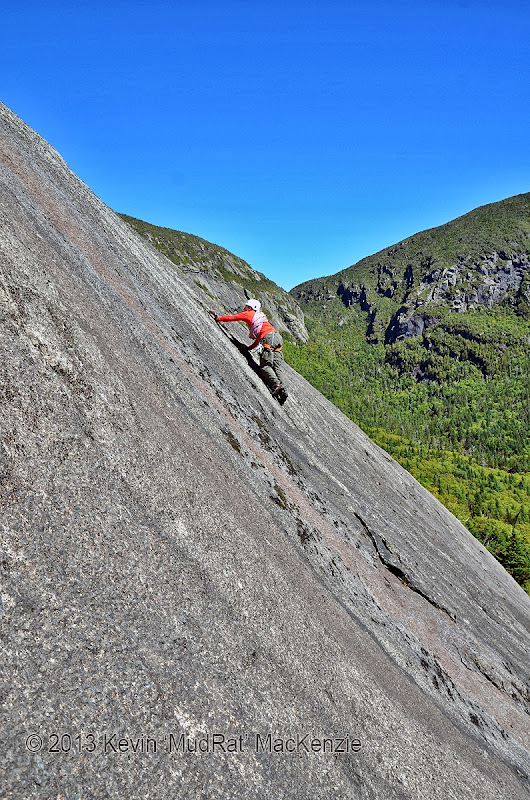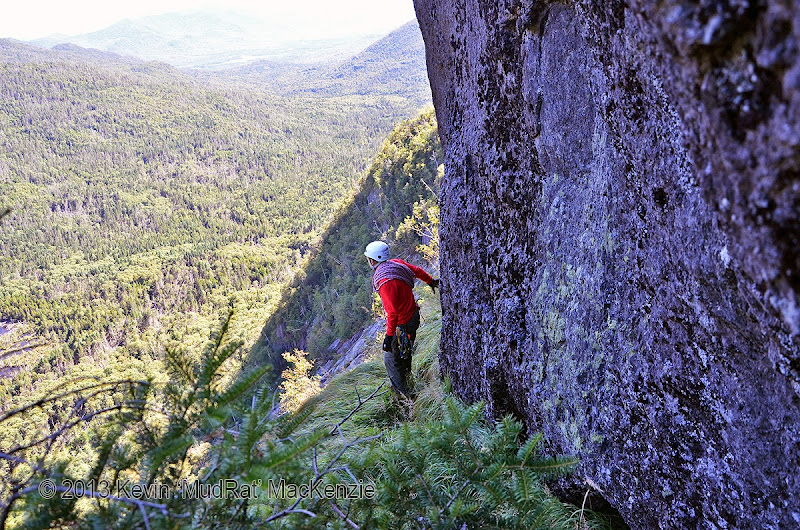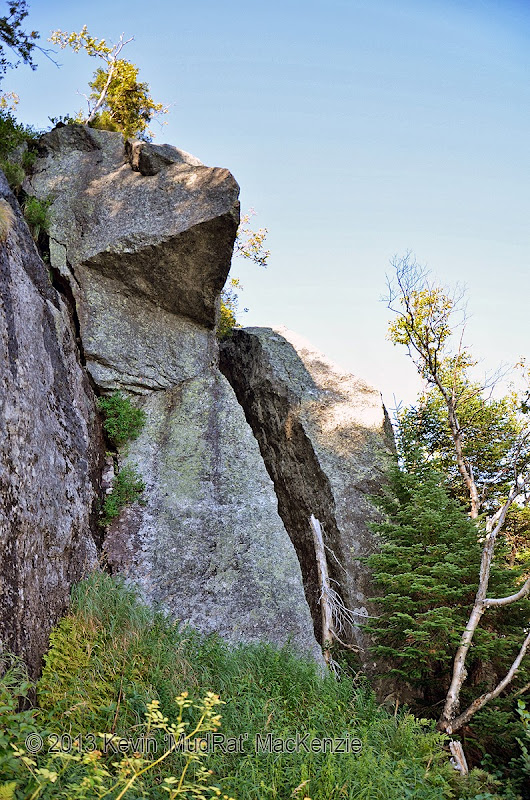Mudrat
Member
DISCLAIMER
Partner: Anthony Seidita
Mileage/Elev.Gain/Duration of Sept. 6: 6 m/3,500 ft./16 hrs.
Benchmarks:
Thursday, Sept. 5:
Photographs
Video: Select 1080HD and Full screen from the options at the bottom of the video.
Route: Slant Rock to Haystack trail junction-Bushwhack south into Panther Gorge-Traverse bottom of Marcy’s East Face ¾ of the way across, Climb face up and to the right to top-Rappel down central fracture-Bushwhack 160 magnetic from southern slide to Marcy Brook-Follow Marcy Brook to Trail near PG Lean-to—Hike Trail over Haystack/Little Haystack to Range Trail-Phelps Trail to Slant Rock.
Special thanks to Taras "Trail Boss" Dejnika for the background picture of the mosaic

Introduction
Panther Gorge holds a place in my heart like no other in the Adirondacks. The remote wilderness, deep forested valley and magnificent rock on all sides tickle my imagination and curiosity every time I bushwhack it. Pillars of stone in front of towering fractured walls…nature’s masterpieces guard the northern entrance; the south is gentler along Marcy Brook though it’s a test to enter or exit from any direction.
Then there’s the stunning east face of Marcy is arguably the crown jewel of the gorge in my opinion: about 550 feet high and a quarter mile wide between Grand Central Slide and the southern edge of the face. The slab is cleaved in the center by a mighty fracture…still a questionable route down before this outing. Neither slide nor the slab was an area that I dreamed of being near since I first viewed it from Mt. Haystack in 2004.
A half a decade later its mystique (and report by Craig i.e. ElectricMan) drew me into a climb of Grand Central Slide. Each subsequent visit (this was my fifth) added another piece to a puzzle I didn’t even realize existed. Scott van Laer and I climbed a portion of the face a couple weeks prior to this; for a week I thought about returning to climb the face directly. I couldn’t see all the way across from the side and the view from Haystack makes everything look vertical, so I didn’t really know what to expect. Therein was some of the draw!
I studied my photos for hours, memorizing various nuances of the area and possible belay stations until I had a vague idea of what to expect for at least a portion at the top. The day would involve a bushwhack down into Panther Gorge from the north, 500 vertical feet of face climbing and 6 rappels down the central fracture. Our exit back to camp would involve a second bushwhack in the gorge to Marcy Brook and Panther Gorge Lean-to. The final leg would take us up one of the steepest trails in the ‘daks over Mt. Haystack and Little Haystack back to Slant Rock.
Approach and Camp
Anthony Seidita (DeepForest) and I planned a weekend of exploring with a hefty agenda: a day in Panther Gorge with a combination solo/technical climb up Marcy’s East Face and possibly top-roping Basin’s Amphitheater. Slant Rock seemed like a perfect jump off point for both. Thursday, September 5th found us beginning our hike to camp from the Garden Trailhead at 8:00 p.m.
My 65 pound pack made progress over the 7-mile trek slow, but stimulating conversation with a good friend made it enjoyable. Before I knew it the time was nearly midnight and we were busy setting up camp. The lean-to was taken, so Anthony erected a tent cover at the closest camping area just up the path. We agreed to get up at 6:30 a.m. to begin the most ambitious day in Panther Gorge.
Into Panther Gorge and on the Slab
A restless night’s sleep over 5.5 hours did nothing to help my ambition as I begrudgingly rolled out of bed. We embarked up the Phelps Trail at 7:45 a.m. upon what would become a 16-hour day. The trek up to the Range Trail junction marked the start of the bushwhack into Panther Gorge—a nice warm up. Once off-trail, I found traces of my passage from two weeks early and smiled inside while pushing the balsams aside; I was “home” again.

Bottom of Grand Central Slide in morning light.
Though I can usually retrace my steps, I fell slightly askew of my normal route which landed us too close to the central drainage, an area of immense boulders, rotten logs and hanging moss. Man-eating holes, leg-breakers at best, were all around and our descent slowed. It took over an hour to reach the bottom of the gorge where a new band of deadfall slowed us further. We arrived low in the drainage of Grand Central Slide which had been gutted slightly since last year.
We’d traversed across the base of the East Face and were ready to climb by noon. I could feel my internal butterflies come to life--frantically flapping from a mixture of excitement and urgency to be cautious as we began a committed climb up a route based on a few pictures and some educated guesses. After a silent prayer, we were ascending.
We began the route up a beautiful brown and white water line; the rock was grippy with small pockets from differential weathering. The occasional flake provided a nice hand or foothold when needed. We approached a bulge in the face where I traversed left toward a grassy ramp—nice natural protection. Anthony explored a more exposed area, but ran into crumbly lichen and traversed to my position. The pitch grew steeper and our exposure increased with every step while climbing alongside the corner. Chunks of feldspar offered bomb-proof security underfoot.

Anthony approaching a bulge in the face near a bit of lichen.

Kevin looking at the choices.

Crossing over a grassy corner.
I watched Anthony climb over the small wall and continue upward. We were now fully committed and my inner voice changed from a distant drone to an imperative yell. I vocalized my desire to begin a protected climb and Anthony agreed. I only needed to wait for him to reach a small ramp where he could set up an anchor and belay. Such was our first half hour on a beautiful face with the western flank of Haystack as witness.
A precarious island of trees about 100 feet up to the right was our target. A large dead tree differentiated it from some other smaller islands. There was no beta, so the nature of the anchors and stance itself were unknown; we were now exploring in every sense of the word. It was time to create a safe route by simply reading the terrain. Anthony led the way as I belayed. A decent overlap of anorthosite held a cam firmly, but protection was quite limited overall. The first traverse went well and I followed as he belayed from the tree island. The face broke 45 degrees with many steeper segments en route. We were now about 200 feet from the southern edge.

Route over to the distant belay point with the dead tree...about 90 feet.
Distant pictures from Haystack hinted at what was beyond, but everything looks nearly vertical from afar. My pictures from the trip with Ranger Scott hinted at a possible line at the same elevation to the north where balsams trees grew near a dihedral. My stomach dropped as we studied the daunting traverse over to that position. Above, however, was a dicey section of steep face overgrown with moss. Small areas of rock showed through, but it looked dangerous. More concerning was the fact that we were above an ever enlarging bulge that crosses the center of the face from left to right. It begins as a small hump and becomes a broken vertical cliff as it approaches Grand Central Slide to the north. Falling would be catastrophic so protection was critical.
I belayed Anthony as he crossed the face and walked up a minute ramp to a nearly level break in the face about 40 feet over. A small overlap held a cam after he cleaned it out. This was my first multi-pitch climb and I felt the pressure as I watched. He spent nearly an hour searching various places for a decent line of ascent. The face adjacent to the aforementioned dihedral was mossy; he tried a few steps up before backing off. I watched the moss crumble underfoot and tumble down the face and out of sight. Finally, he settled on cleaner yet less protected slab climb leading to a 10 foot wall. He placed a 2” cam elbow deep in a crack and set his mind to the next problem.
CONTINUED BELOW...
Partner: Anthony Seidita
Mileage/Elev.Gain/Duration of Sept. 6: 6 m/3,500 ft./16 hrs.
Benchmarks:
Thursday, Sept. 5:
- Begin: 8:00 p.m.
- Slant Rock: 11:45 p.m.
- Bed: 1:00 a.m.
- Start: 7:45 a.m.
- Haystack Trail/Begin Bushwhack: 8:30
- Grand Central Drainage: 10:30
- Begin Climb: 12:00 p.m.
- Begin Rappel: 4:30 p.m.
- Bottom of Face: 6:30 p.m.
- Trail at Panther Gorge: 7:40 p.m.
- Haystack summit: 9:30 p.m.
- Camp: 11:30 p.m.
- Bed: 1:00 a.m.
Photographs
Video: Select 1080HD and Full screen from the options at the bottom of the video.
Route: Slant Rock to Haystack trail junction-Bushwhack south into Panther Gorge-Traverse bottom of Marcy’s East Face ¾ of the way across, Climb face up and to the right to top-Rappel down central fracture-Bushwhack 160 magnetic from southern slide to Marcy Brook-Follow Marcy Brook to Trail near PG Lean-to—Hike Trail over Haystack/Little Haystack to Range Trail-Phelps Trail to Slant Rock.
Special thanks to Taras "Trail Boss" Dejnika for the background picture of the mosaic

Introduction
Panther Gorge holds a place in my heart like no other in the Adirondacks. The remote wilderness, deep forested valley and magnificent rock on all sides tickle my imagination and curiosity every time I bushwhack it. Pillars of stone in front of towering fractured walls…nature’s masterpieces guard the northern entrance; the south is gentler along Marcy Brook though it’s a test to enter or exit from any direction.
Then there’s the stunning east face of Marcy is arguably the crown jewel of the gorge in my opinion: about 550 feet high and a quarter mile wide between Grand Central Slide and the southern edge of the face. The slab is cleaved in the center by a mighty fracture…still a questionable route down before this outing. Neither slide nor the slab was an area that I dreamed of being near since I first viewed it from Mt. Haystack in 2004.
A half a decade later its mystique (and report by Craig i.e. ElectricMan) drew me into a climb of Grand Central Slide. Each subsequent visit (this was my fifth) added another piece to a puzzle I didn’t even realize existed. Scott van Laer and I climbed a portion of the face a couple weeks prior to this; for a week I thought about returning to climb the face directly. I couldn’t see all the way across from the side and the view from Haystack makes everything look vertical, so I didn’t really know what to expect. Therein was some of the draw!
I studied my photos for hours, memorizing various nuances of the area and possible belay stations until I had a vague idea of what to expect for at least a portion at the top. The day would involve a bushwhack down into Panther Gorge from the north, 500 vertical feet of face climbing and 6 rappels down the central fracture. Our exit back to camp would involve a second bushwhack in the gorge to Marcy Brook and Panther Gorge Lean-to. The final leg would take us up one of the steepest trails in the ‘daks over Mt. Haystack and Little Haystack back to Slant Rock.
Approach and Camp
Anthony Seidita (DeepForest) and I planned a weekend of exploring with a hefty agenda: a day in Panther Gorge with a combination solo/technical climb up Marcy’s East Face and possibly top-roping Basin’s Amphitheater. Slant Rock seemed like a perfect jump off point for both. Thursday, September 5th found us beginning our hike to camp from the Garden Trailhead at 8:00 p.m.
My 65 pound pack made progress over the 7-mile trek slow, but stimulating conversation with a good friend made it enjoyable. Before I knew it the time was nearly midnight and we were busy setting up camp. The lean-to was taken, so Anthony erected a tent cover at the closest camping area just up the path. We agreed to get up at 6:30 a.m. to begin the most ambitious day in Panther Gorge.
Into Panther Gorge and on the Slab
A restless night’s sleep over 5.5 hours did nothing to help my ambition as I begrudgingly rolled out of bed. We embarked up the Phelps Trail at 7:45 a.m. upon what would become a 16-hour day. The trek up to the Range Trail junction marked the start of the bushwhack into Panther Gorge—a nice warm up. Once off-trail, I found traces of my passage from two weeks early and smiled inside while pushing the balsams aside; I was “home” again.

Bottom of Grand Central Slide in morning light.
Though I can usually retrace my steps, I fell slightly askew of my normal route which landed us too close to the central drainage, an area of immense boulders, rotten logs and hanging moss. Man-eating holes, leg-breakers at best, were all around and our descent slowed. It took over an hour to reach the bottom of the gorge where a new band of deadfall slowed us further. We arrived low in the drainage of Grand Central Slide which had been gutted slightly since last year.
We’d traversed across the base of the East Face and were ready to climb by noon. I could feel my internal butterflies come to life--frantically flapping from a mixture of excitement and urgency to be cautious as we began a committed climb up a route based on a few pictures and some educated guesses. After a silent prayer, we were ascending.
We began the route up a beautiful brown and white water line; the rock was grippy with small pockets from differential weathering. The occasional flake provided a nice hand or foothold when needed. We approached a bulge in the face where I traversed left toward a grassy ramp—nice natural protection. Anthony explored a more exposed area, but ran into crumbly lichen and traversed to my position. The pitch grew steeper and our exposure increased with every step while climbing alongside the corner. Chunks of feldspar offered bomb-proof security underfoot.

Anthony approaching a bulge in the face near a bit of lichen.

Kevin looking at the choices.

Crossing over a grassy corner.
I watched Anthony climb over the small wall and continue upward. We were now fully committed and my inner voice changed from a distant drone to an imperative yell. I vocalized my desire to begin a protected climb and Anthony agreed. I only needed to wait for him to reach a small ramp where he could set up an anchor and belay. Such was our first half hour on a beautiful face with the western flank of Haystack as witness.
A precarious island of trees about 100 feet up to the right was our target. A large dead tree differentiated it from some other smaller islands. There was no beta, so the nature of the anchors and stance itself were unknown; we were now exploring in every sense of the word. It was time to create a safe route by simply reading the terrain. Anthony led the way as I belayed. A decent overlap of anorthosite held a cam firmly, but protection was quite limited overall. The first traverse went well and I followed as he belayed from the tree island. The face broke 45 degrees with many steeper segments en route. We were now about 200 feet from the southern edge.

Route over to the distant belay point with the dead tree...about 90 feet.
Distant pictures from Haystack hinted at what was beyond, but everything looks nearly vertical from afar. My pictures from the trip with Ranger Scott hinted at a possible line at the same elevation to the north where balsams trees grew near a dihedral. My stomach dropped as we studied the daunting traverse over to that position. Above, however, was a dicey section of steep face overgrown with moss. Small areas of rock showed through, but it looked dangerous. More concerning was the fact that we were above an ever enlarging bulge that crosses the center of the face from left to right. It begins as a small hump and becomes a broken vertical cliff as it approaches Grand Central Slide to the north. Falling would be catastrophic so protection was critical.
I belayed Anthony as he crossed the face and walked up a minute ramp to a nearly level break in the face about 40 feet over. A small overlap held a cam after he cleaned it out. This was my first multi-pitch climb and I felt the pressure as I watched. He spent nearly an hour searching various places for a decent line of ascent. The face adjacent to the aforementioned dihedral was mossy; he tried a few steps up before backing off. I watched the moss crumble underfoot and tumble down the face and out of sight. Finally, he settled on cleaner yet less protected slab climb leading to a 10 foot wall. He placed a 2” cam elbow deep in a crack and set his mind to the next problem.
CONTINUED BELOW...














